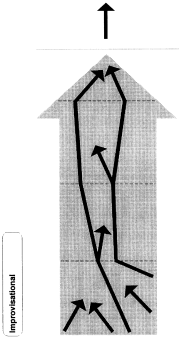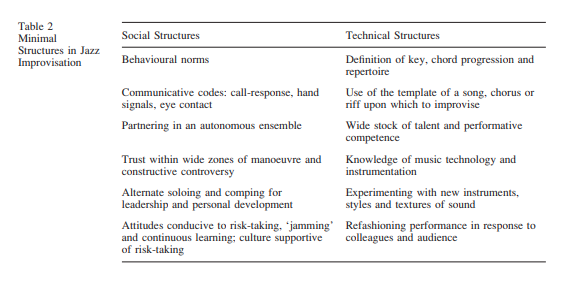Learning from the Greats. A summary of Jazz Quotes:
Charles Mingus: ‘"You can’t improvise on nothin’, man. You gotta improvise on somethin’". AND "In my music, I am trying to play the truth in what I am. The reason it's difficult is because I am changing all the time.
Wynton Marsalis: "In Jazz, improvisation isn't a matter of just making any ol' thing up. Jazz, like any language, has its own grammer and vocabulary. There's no right or wrong, just some choices that are better than others." AND "Through improvisation, jazz teaches you about yourself. And through swing, it teaches you that other people are individuals too. It teaches you how to coordinate with them."
George Gershwin: "Life is a lot like jazz. It's best when you improvise."
Cecil Taylor: "Improvisation is the ability to talk to oneself."
Sonny Rolins: "I feel that Jazz improvisation is the ultimate. You have to create on the spot, the essence of this music."
Mose Allison: "As far as I'm concerned, the essentials of jazz are: melodic improvisation, melodic invention, swing, and instrumental personality."
Ahmad Jamal: "Jazz Improvisation means that practice is not as straightforward as it would be when you simply have a score to play."
Thelonious Monk: " I don't know were jazz is going. Maybe it's going to hell. You can't make anything go anywhere. It just happens."
Oscar Peterson: "It's group sound that's important. You not only have to know your own instrument, you must know the others and how to back them up at all times.
Miles Davis: "Do not fear mistakes. There are none."
Louis Armstrong: "There are only two ways to sum up music: Either it's good or it's bad. If it's good you don't mess with it, you just enjoy it.
Duke Ellington: "By enlarge jazz has always been like the kind of man you wouldn't want your daughter to associate with."
John Coltrane: "My music is the spiritual expression of what I am- my faith, my knowledge, my being... When you begin to see the possibilities of music, you desire to do something really good for people to help humanity free itself from its hang-ups... I want to speak to their souls."
Charlie Parker: "Music is your own experience, your thoughts, your wisdom. If you don't live it, it won't come out of your horn. They teach you there's a boundary line to music. But, man, there's no boundary line to art." AND "Don't play the saxophone, let it play you."
Billy Holiday: "I can't stand to sing the same song the same way two nights in succession. If you can, than it ain't music. its a close order drill, or exercise or yodeling or something not music.
Bill Evans: "What bugs me is when people try to analyze jazz as an intellectual theorem. It's not. It's feeling.
Dizzy Gillespie: '"It's taken me all my life to learn what not to play"



 is essential to a more speedy recovery.
is essential to a more speedy recovery. . Wishing you a speedy recovery!
. Wishing you a speedy recovery!